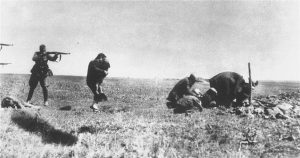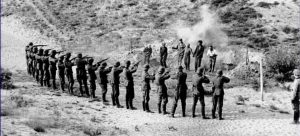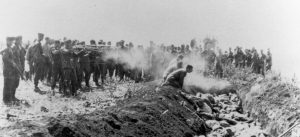Adolph Hitler’s decision to invade the Soviet Union on June 22, 1941, is a key turning point in World War II. Called Operation Barbarossa, it caused millions of military and civilian casualties. Long before the military strategy was drawn up, though, Hitler made clear that one of his goals was exterminating wide swathes of Russian society.
Hitler’s enmity for the Soviet Union was long-standing. In his 1925 book, Mein Kampf, he called its leaders “the scum of humanity” and described Bolshevism as a “spawn of hell” and part of a Jewish plan for world domination. Hitler saw the signing of a German-Soviet nonaggression pact on August 23, 1939, as a temporary measure. A secret protocol in it split Poland between them and ensured Germany could invade Poland unopposed, which it did nine days later.
Yet, Hitler’s opinion of the Soviet Union hadn’t changed. One day before the agreement was signed, Hitler held a private conference with his military leaders. According to historian Alan Clark, Hitler told his generals that the pact “was meant only to stall for time” and, in time, “we will crush the Soviet Union.”
Gen. Franz Halder was the German Army Chief of Staff from September 1, 1938, until September 24, 1942. Hitler forced him to retire due to disagreements over military strategy and Halder would end up in Dachau after an attempted assassination of Hitler on July 20, 1944. While chief of staff, Halder kept a private journal that would be introduced into evidence at the Nuremberg Trials.
According to Halder’s journal, Hitler told a July 31, 1940, military conference, “The sooner Russia is crushed, the better off we shall be.” He instructed the military to begin planning for a May 1941 invasion. On December 18, 1940, Hitler issued Führer Directive No. 21, formally ordering that plans “to crush Soviet Russia in a rapid campaign” be completed by May 15, 1941. (Italics in original).
Documents introduced at the Nuremberg War Trials show that, on March 14, Hitler advised the armed forces that SS leader Heinrich Himmler would be “entrusted with special tasks” in areas taken by German troops. (Italics in original). Moreover, Himmler could “act independently” of the armed forces. Some insight into the SS’s ambit may have emerged in a meeting Halder had with Hitler three days later. According to his war journal, Hitler said Soviet intelligentsia “must be exterminated” and “force must be used in its most brutal form” throughout the country.
At the end of March, Hitler told military leaders that few rules would govern German forces in Soviet Russia. “This is a war of extermination,” Halder recorded Hitler as saying, so military commanders “must make the sacrifice of overcoming their personal scruples.” This is followed in the journal by the incongruous “Noon — All invited to lunch.”

Einsatzruppen soldiers executing Ukrainians
As the invasion approached, Hitler’s pronouncements were incorporated into formal strategy and planning documents. A May 11, 1941, directive from Gen. Georg-Hans Reinhardt to his Panzer tank forces said, ““The aim of this fight must be to smash the present Russia, and it must, therefore be conducted with utter ruthlessness. The complete merciless annihilation of the enemy must be the inflexible purpose of the planning and execution of every combat operation. In particular no mercy must be shown to the followers of the present Russian-Bolshevist system.”
Two days later, Hitler issued a top-secret decree on military jurisdiction in the Soviet Union “and special measures to be taken by the troops.” Soviet “guerrillas” were to be “ruthlessly liquidated by the troops.” Moreover, “all other attacks by enemy civilians on the armed forces … will be suppressed on the spot by the troops, using the most extreme methods, until the assailants are annihilated” (Italics in original).
Anyone suspected of an offense was to be brought before a German officer, who would decide if “they are to be shot” (Italics in original). Additionally, battalion commanders and above could authorize immediate “collective coercive measures” against localities from which German armed forces were attacked. (Italics in original)
Yet, the military wasn’t obligated to prosecute soldiers who committed offenses against Soviet citizens, even if they were crimes. Any tribunal that pursued charges was required to remember that Germany’s defeat in World War I, the suffering of its people, and opposition to Nazism “were caused primarily by Bolshevist influence and that no German has forgotten this.” Tribunals also were to exercise “[e]xtreme caution” in assessing the credibility of enemy civilians. (Italics in original)
The Army held a meeting in Warsaw on June 11 to explain the decree. Among other things, attendees were told to not “spare the bearer of enemy ideology, but kill him.” Additionally, any civilian who impeded or incited others to impede German troops was to be considered a guerrilla, even persons who distributed leaflets.
The week after the military jurisdiction decree, the German Army issued a top-secret “directive for the conduct” of its troops. The second paragraph advised, “This struggle demands ruthless and energetic measures against Bolshevist agitators, guerrillas, saboteurs, Jews, and the complete elimination of all active or passive resistance.” (Italics in original). They were warned the “Asiatic” Red Army soldiers were especially “unpredictable, insidious and callous.” They were also to remember that the Soviet Union was made up of “a multitude of Slav, Caucasian, and Asiatic peoples” who were “kept together by the power of the Bolshevist rulers” and that “Jewry is strongly represented.” (Italics in original).
On June 6, 1941, the Army issued a secret directive on the treatment of “political commissars.” These were Communist Party officials who oversaw military units, were responsible for political education, and reported directly to party leaders. The contents of the order were sensitive enough that the Armed Forces High Command distributed it only to commanders in chief of the armies, who were to “inform the other commanding generals and commanders by word of mouth.”
The sensitivity arose because the order it was “wrong” to treat commissars in accord with international laws. It reasoned that Soviet treatment of German prisoners of war “will be cruel, inhuman, and dictated by hate.” As a result, all political commissars captured during combat or while offering resistance “must, on principle, be shot immediately.” Any commissars who opposed German troops would fall under Hitler’s military jurisdiction decree, “even if they are only suspected of resistance, sabotage, or instigation thereto.”
Commissars in Soviet military units “will not be recognized as soldiers.” (Italics in original) The Geneva Convention regarding prisoners of war would not apply and, after being segregated from other prisoners, “they are to be liquidated.” Any commissars captured behind German lines were to be handed over to SS death squads.

German troops executing partisans
Even prisoners of war were at risk. The week before the invasion, the Army’s Prisoner-of-War Department issued a letter regarding the handling of POWs. It advised that “ruthless and energetic measures must be used at the slightest sign of resistance, especially against Bolshevist agitators. Complete elimination of any active or passive resistance!” [Sic] Any court proceedings against prisoners weren’t subject to the Geneva Convention, including provisions dealing with death sentences. “Strictest discipline” was to be enforced in POW camps. Conservative estimates say the Germans shot half a million Soviet prisoners of war and another 2.6 million died of starvation or mistreatment, according to historian Timothy Snyder’s book, Bloodlands: Europe Between Hitler and Stalin.
The Army wasn’t alone in planning death for Russians. On May 2, 1941, a meeting was held to develop a broad economic plan for the eastern areas the Nazis planned to occupy. Minutes of the meeting said in part:
1. The war can only be continued if all armed forces are fed by Russia in the third year of the war.
2. There is no doubt that as a result many millions of people will be starved to death if we take out of the country the things necessary for us.
Later that month a so-called “Hunger Plan” was reflected in a set of economic directives. It was equally blunt, saying, “Many tens of millions of people in this area will become redundant and will either die or have to emigrate to Siberia.” One of the primary tasks was to ensure that German troops were completely fed from the occupied territory.
These attitudes continued once the invasion began. Halder met with Hitler on July 6, 1941. According to his journal, “It is the Fuehrer’s firm decision to level Moscow and Leningrad, and make them uninhabitable, so as to relieve us of the necessity of having to feed the populations through the winter.” Hitler also said he didn’t want German troops quartered in Russian villages and towns once winter arrived “because we want to be able to bomb them at any time in the event of uprisings.” Later that month, Field Marshal Wilhelm Keitel, Germany’s highest-ranking military officer, supplemented a Führer Directive when he instructed the military to “maintain order, not by requesting reinforcements, but by employing suitably draconian methods.”
Reichmarshall Herman Göring was in charge of economic planning for the occupied territories. Notes of a September 1941 economic conference reflect an insistence that all food supplies for the troops “have to be furnished by the occupied territories themselves.”(Italics in original) As a result, the only people “to be supplied with an adequate amount of food [are those] who work for us.”
Yet, Hitler’s obsession with exploiting Russia’s agricultural resources may have led to a strategic blunder. By mid-July, two German Panzer tank groups were roughly 200 miles from Moscow. On July 19, though, Führer Directive No. 33 sent one north and the other to Ukraine. When military leaders questioned this, Hitler said Ukraine’s natural resources were a principal objective of the invasion.

Unidentified unit executing Soviet citizens
The attack on Moscow did not resume until October. However, Mother Nature became a factor. Rains created a sea of mud. The mud froze with the arrival of winter in November, by the end of the month, temperatures reached -40° F. Exhausted German troops also lacked sufficient winter clothing. By the time a December 5 Soviet counteroffensive forced the Germans to retreat, German soldiers reported more than 130,000 cases of frostbite.
It’s unlikely capturing Moscow in July would have ended the war. Still, with the Panzer support, an all-out attack on the city would have had an undeniable psychological and perhaps brought down the Soviet government.
Regardless, what stands out about the goals of the invasion is the focus on “Bolsheviks” or ordinary people. Jews were not specifically or exclusively the target. Still, the four Einsatzgruppen, SS mobile killing units, that followed the Army in the invasion for “special tasks” were lethal. Author Richard Rhodes says Einsatzgruppen records indicate they executed at least 738,827 Jewish men, women, and children during the Russian campaign. Yet, he believes even that figure is low.
Germany’s defeat meant the genocidal directives and the “Hunger Plan” never came to full fruition. Genocide doesn’t have a quantitative threshold, though. International law now asks if there’s an “intent to destroy, in whole or in part, a national, ethnical, racial or religious group.”
From the outset, the Soviet population was a primary target of the invasion. It’s estimated 20 million or more Soviet civilians died in the war, some 10 percent of the population. Is it necessary to create discrete category counts? In the end, there’s no question that hundreds of thousands of Jews, Ukrainians, Russians, Slavs, and others were the victims of planned mass murder.
It was the beginning of a premeditated genocide on a colossal scale. The population was divided into racial categories, with “undesirable” elements of “superfluous mouths” being left to starve or simply murdered.
Rolf-Dieter Müller, Hitler’s War in the East, 1941-1945: A Critical Assessment
(Originally posted on History of Yesterday)







